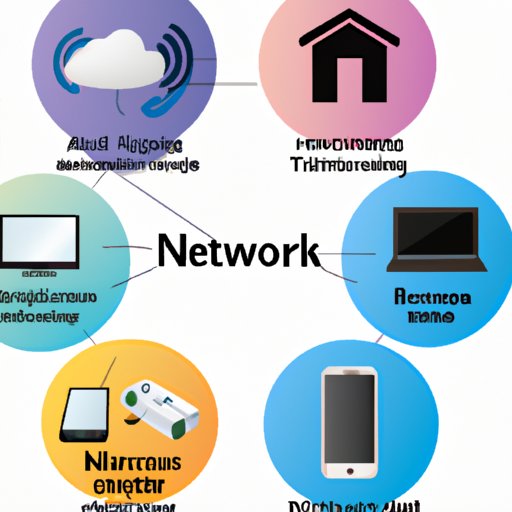Introduction
Network technology is an essential component of modern businesses. It enables businesses to increase efficiency, enhance security, reduce costs, and improve communication and collaboration. But what exactly is network technology? In this article, we’ll explore the definition of network technology, the components that make it up, the benefits it offers, common types, and the challenges associated with implementing it.
An Overview of Network Technology: What is it and How Does it Work?
Network technology is a group of devices connected together to facilitate data sharing and communication. These devices are connected through a medium, such as cables, wireless signals, or optical fibers. The devices can be computers, printers, servers, routers, switches, etc. The network is then managed by software and protocols, which dictate how the data is transferred between the devices.
Basic Components of Network Technology
To understand how a network works, it’s important to understand the basic components that make it up. These components include:
- Nodes: Nodes are the individual devices that make up the network. They can be computers, printers, servers, routers, switches, etc.
- Media: Media refers to the physical medium through which the nodes communicate. This can be cables, wireless signals, or optical fibers.
- Protocols: Protocols refer to the rules and regulations that govern how the data is transferred between the nodes.
Different Types of Networks
There are several different types of networks that can be deployed depending on the needs of the organization. Some of the most common types of networks include:
- Local Area Networks (LANs): LANs are used to connect computers and other devices within a small geographic area, such as a home or office building.
- Wide Area Networks (WANs): WANs are used to connect computers and other devices over a large geographic area, such as across cities or even countries.
- Wireless Networks: Wireless networks use radio waves or infrared signals to connect computers and other devices without the need for physical cables.
Data Packets and Protocols
In order to send and receive data, network devices must be able to break down data into smaller units known as packets. These packets are then sent from one device to another using protocols. Protocols are the rules and regulations that govern how the data is transmitted and received.
For example, the Transmission Control Protocol/Internet Protocol (TCP/IP) is a set of protocols that are used to send data over the Internet. It breaks down data into packets, sends them over the network, and reassembles them at the destination. Other protocols, such as Ethernet, are used to manage local networks.
Exploring the Benefits of Network Technology
Network technology offers numerous benefits to businesses. According to a study by the University of California San Diego, “The use of computer networks has increased productivity, reduced costs, improved customer service, and enabled new services.” Here are some of the key benefits of network technology:
Increased Efficiency
One of the key benefits of network technology is that it can help businesses increase their efficiency. By connecting computers and other devices, employees can share data and collaborate more effectively. This can lead to faster decision-making and improved productivity.
Enhanced Security
Network technology can also help businesses enhance their security. With the right security measures in place, businesses can protect their data from unauthorized access. This includes encrypting data, using firewalls, and restricting access to certain parts of the network.
Reduced Costs
Another benefit of network technology is that it can help businesses reduce their costs. By connecting devices, businesses can eliminate the need for multiple hardware and software licenses. This can help them save money in the long run.

Common Types of Network Technologies
As mentioned earlier, there are several different types of network technologies that businesses can deploy. Here are some of the most common types:
Local Area Networks (LANs)
Local Area Networks (LANs) are used to connect computers and other devices within a small geographic area. They are typically used to connect computers and other devices within a single office building or home. LANs are typically connected using cables, but they can also be connected wirelessly.
Wide Area Networks (WANs)
Wide Area Networks (WANs) are used to connect computers and other devices over a large geographic area. They are often used to connect offices in multiple cities or countries. WANs are typically connected using cables, but they can also be connected wirelessly.
Wireless Networks
Wireless networks use radio waves or infrared signals to connect computers and other devices without the need for physical cables. They are often used to connect mobile devices, such as laptops and smartphones, to the Internet. They are also used to connect devices within a home or office.

The Role of Network Technology in Business
Network technology plays a key role in business operations. Here are some of the ways it can help:
Improved Communication
Network technology can help businesses improve their communication. By connecting computers and other devices, businesses can quickly and easily share data and communicate with each other. This can help them improve their decision-making and collaboration.
Automation of Processes
Network technology can also help businesses automate processes. By connecting computers and other devices, businesses can automate tasks, such as data entry and document management. This can help them save time and reduce errors.
Improved Collaboration
Finally, network technology can help businesses improve their collaboration. By connecting computers and other devices, employees can work together more effectively. This can lead to better decision-making and improved productivity.

Challenges and Solutions for Implementing Network Technology
Although network technology offers numerous benefits, there are also some challenges associated with its implementation. Here are some of the key challenges and potential solutions:
Cost
One of the biggest challenges associated with implementing network technology is the cost. Network equipment and software can be expensive. To address this challenge, businesses should look for ways to reduce costs, such as using open source software and purchasing used equipment.
Complexity
Another challenge associated with implementing network technology is its complexity. Setting up and managing a network can be complicated and time-consuming. To address this challenge, businesses should look for ways to simplify the process, such as using automated tools and services.
Security
Finally, security is another challenge associated with implementing network technology. To address this challenge, businesses should implement the necessary security measures, such as encrypting data, using firewalls, and restricting access to certain parts of the network.
Conclusion
Network technology plays a key role in business operations. It can help businesses increase efficiency, enhance security, reduce costs, and improve communication and collaboration. While there are some challenges associated with its implementation, these can be addressed with the right strategies and solutions.
Summary of Benefits of Network Technology
Network technology offers numerous benefits to businesses, including increased efficiency, enhanced security, and reduced costs. It can also help businesses improve communication, automate processes, and improve collaboration.
Key Takeaways
Network technology is a group of devices connected together to facilitate data sharing and communication. There are several different types of networks, such as Local Area Networks (LANs), Wide Area Networks (WANs), and Wireless Networks. Network technology offers numerous benefits to businesses, but there are also some challenges associated with its implementation, such as cost, complexity, and security. By understanding these challenges and implementing the right solutions, businesses can take advantage of the benefits of network technology.
(Note: Is this article not meeting your expectations? Do you have knowledge or insights to share? Unlock new opportunities and expand your reach by joining our authors team. Click Registration to join us and share your expertise with our readers.)
